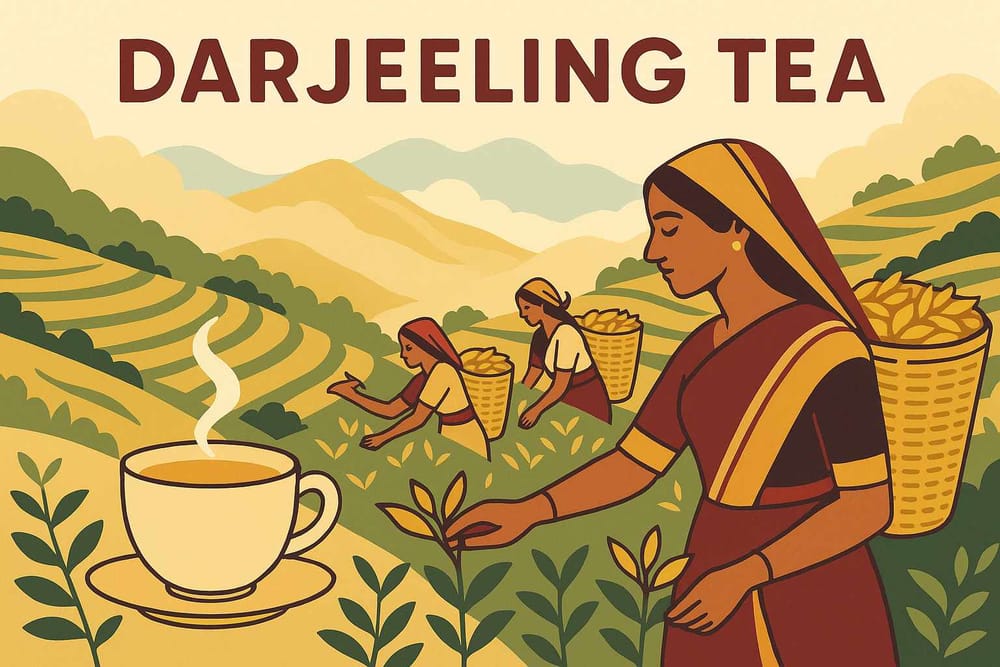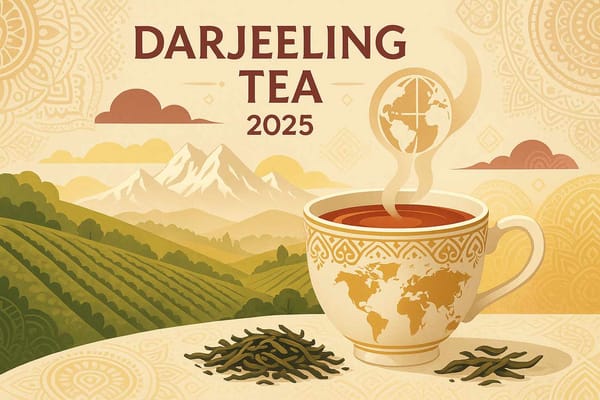
The Rich Legacy of Darjeeling Tea- Cultivation Harvest and Flavor Explained
There’s a certain magic in the first cup of tea of the day, isn’t there? As the warm steam rises, it feels like a quiet conversation with an old friend. For most of us in India, chai is a simple, comforting ritual. But sometimes, you come across a brew that feels like poetry in a cup. That, my friends, is the experience of sipping Darjeeling tea. It's not just a beverage; it’s a story, a legacy, a whisper from the misty Himalayan slopes, affectionately called the "Champagne of Teas."
A Story Planted in the Hills: The British Raj and a Surgeon's Dream
The tale of Darjeeling tea begins not with an ancient Indian tradition, but in the 1840s, during the British colonial era. A civil surgeon named Dr. Archibald Campbell decided to try something new. He planted Chinese tea seeds (*Camellia sinensis var. sinensis*) in his garden in Darjeeling, simply to see if they would grow in the cool, crisp mountain air. Little did he know, his little experiment would blossom into a global legacy. The unique combination of altitude, misty weather, and slightly acidic soil was the perfect recipe for something extraordinary.
Soon, iconic tea estates like Makaibari and Happy Valley took root, and by the 20th century, this Himalayan brew was famous worldwide. During India's struggle for freedom, it even became a symbol of our own ability to produce world-class goods. Today, its heritage is so precious that it's protected by a Geographical Indication (GI) tag, a promise that what you're drinking is the real, authentic essence of Darjeeling.
Nature's Own Recipe: The Magic of Darjeeling's Terroir
So, what makes this tea so special that it can't be replicated anywhere else in the world? The secret lies in the very earth it grows in. The tea gardens are perched on steep slopes, at altitudes between 600 and 2,000 meters. This height makes the tea plants grow slowly, allowing them to develop a deeper, more complex flavour.
The cool, moist air, the generous monsoon rains, and the well-drained loamy soil all come together to create a unique ecosystem. This environment gives Darjeeling tea its signature muscatel flavour – a delightful, slightly fruity, grape-like note that is its most cherished characteristic. It’s a taste that is truly born from the mountains.
A Labour of Love: The Art of Plucking and Processing
Growing Darjeeling tea is an art form passed down through generations. On the 87 certified estates, tradition is paramount. The bushes are pruned with care, and many estates are now embracing organic farming to keep the soil and the tea pure. The most crucial part of the process, however, is the plucking.
Skilled workers, mostly women, meticulously hand-pick only the most tender part of the plant: the top two leaves and a bud. This delicate process ensures that only the finest leaves make it into your cup. It's a challenging job, especially on the steep slopes, and it’s this human touch and dedication that truly defines the quality of Darjeeling tea.
Seasons in a Cup: The Four Flushes of Darjeeling
The flavour of Darjeeling tea changes dramatically with the seasons. Each harvest period, known as a "flush," offers a unique taste experience.
- First Flush (Spring: March - May): This is the first harvest after the winter dormancy. The tea is light, fresh, and has a vibrant, floral aroma with a hint of crispness. It’s often called the most delicate of the flushes, a true taste of spring in the Himalayas.
- Second Flush (Early Summer: May - June): Considered by many to be the best, this flush delivers the famous muscatel flavour. The leaves produce a fuller-bodied, amber-coloured liquor with rich, fruity notes that are simply unforgettable.
- Monsoon Flush (Rainy Season: July - September): As the rains pour down, the tea plants grow vigorously. This results in a stronger, more robust tea with earthy undertones. While less complex, it has a bold character and is often used in blends.
- Autumnal Flush (Late Autumn: October - November): After the monsoon, the final harvest of the year yields a tea that is smooth, mellow, and full-bodied. It has a beautiful copper hue and a soft, nutty flavour, making it a perfect, comforting brew for cooler days.
More Than a Drink: A Ritual of Warmth and Connection
In India, offering tea is a gesture of hospitality, a way of welcoming someone into your home and heart. Darjeeling tea, with its elegance, takes this ritual to another level. It’s the tea you bring out for special guests or enjoy during a quiet moment of reflection. This deep connection between food, drink, and community is a cornerstone of our culture, much like the way we celebrate festivals with local flavors and traditional dishes.
Many wonder, what truly sets Darjeeling tea apart? It’s this combination of its unique geography, the meticulous hand-crafting, and the distinct flavours of each flush. It’s a tea that demands to be savoured and appreciated.
And that famous title, the 'Champagne of Teas'—it isn't just a marketing gimmick. So, why is it called that? Just as true Champagne can only come from its namesake region in France, authentic Darjeeling tea can only be grown in the specific tea gardens of the Darjeeling and Kalimpong districts. This exclusivity, combined with its refined and complex flavour, earns it this prestigious comparison.
Brewing the Perfect Cup to Honour its Flavour
To truly enjoy the delicate notes of Darjeeling tea, it’s important to brew it correctly. Use fresh, filtered water and bring it just short of a full boil, around 90-95°C. Boiling water can burn the delicate leaves. Let the tea steep for about 3-4 minutes. Most connoisseurs agree that it’s best enjoyed plain, without milk or sugar, to allow its natural floral and muscatel notes to shine through.
At Bhaktilipi, we believe in celebrating and preserving these timeless traditions. Whether it's the rich story behind a cup of tea or the deep wisdom in our devotional literature, these are the threads that weave our cultural fabric. We strive to share these stories in a way that resonates with today's world, keeping the essence pure and the connection strong.
If you cherish the authenticity of Indian traditions, we invite you to explore our world. At Bhaktilipi.in, you'll find a space dedicated to the profound wisdom of our culture. We believe that true devotion can be found in appreciating the beauty around us, from ancient texts to the perfect cup of tea. Stay connected with our journey by following us on YouTube and Instagram.
A Heritage Brewed in Every Sip
So, the next time you hold a warm cup of Darjeeling tea, take a moment. Inhale its delicate aroma. Let the complex flavours dance on your tongue. Remember that you are not just drinking tea. You are sipping a piece of history, a gift from the Himalayas, and a testament to the hard work of generations. You are tasting a legacy that continues to thrive, one precious leaf at a time.
A passionate group of people dedicated to preserving India's knowledge of Dharma, Karma, and Bhakti for ourselves and the world 🙏.
Comments
Related in

The Global Influence and Legacy of Darjeeling Tea - A 2025 Perspective
There's a certain magic in the steam that rises from a freshly brewed cup of Darjeeling tea. It’s not just the warm, fragrant air that fills the room; it feels like you're inhaling the very essence of the misty mountains. It’s a feeling I’
